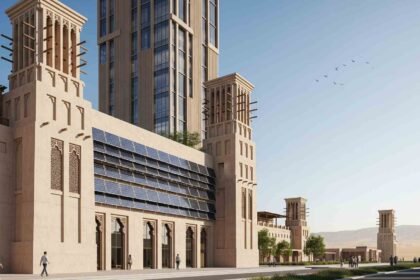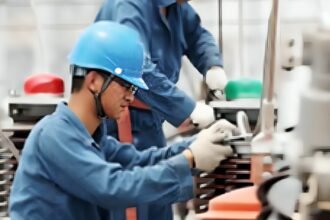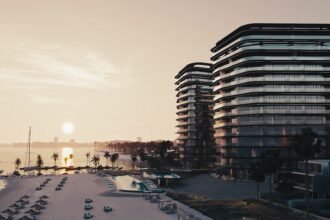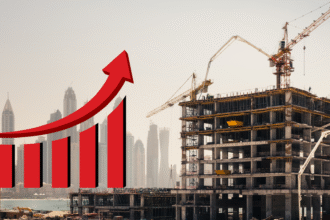Dubai has taken a major step forward in its infrastructure ambitions with its latest landmark: the Dubai Metro Blue Line. Worth AED 20.5 billion (USD 5.6 billion), this massive project has secured critical financial backing from Emirates, underscoring the city’s determination to build a cutting-edge, sustainable, and seamlessly connected public transport network.
In mid-July 2025, Emirates NBD confirmed it had arranged and fully underwritten a syndicated bond facility of AED 3.9 billion ($1.06 billion) in support of the project. The financial package categorized under the bank’s “Green Financing” initiative for clean transportation bolsters the project’s scale and highlights Dubai’s commitment to eco-friendly urban growth. This bond facility is part of broader funding arrangements essential to realizing the Blue Line.
The Roads and Transport Authority awarded the contract for the construction of the Blue Line to a consortium comprising Turkey’s MAPA and Limak and China’s state-owned CRRC. The RTA also appointed Parsons Corporation as the project management consultant to oversee design review, procurement, and construction supervision.
Spanning approximately 30 kilometers, the Blue Line will feature 14 stations, with an almost even split between elevated and underground segments about 15.5 km underground and 14.5 km elevated. It will weave its way through strategic zones including Dubai Creek Harbour, Ras Al Khor industrial area, Dubai International City (including three phases), Dubai Silicon Oasis, Dubai International Academic City, Mirdif City Centre, and Al Warqa’a.
This design implements critical interchanges at Centrepoint linking with the Red Line and Creek linking with the Green Line, facilitating smooth passenger transfers.
Promoted under the Dubai 2040 Urban Master Plan, the Blue Line is more than a transportation project; it’s a strategic enabler of urban development, easing traffic congestion and lowering carbon emissions. It is forecast to serve around 350,000 passengers daily by 2040, reducing traffic by approximately 20% on key road corridors.
The metro’s projected operational date is September 2029, strategically timed to mark the twentieth anniversary of Dubai’s first metro line. This completion timeline aligns with population projections and major urban events, ensuring the city remains well-connected and future-ready.
In RTA’s own words, supported by project stakeholders, the Blue Line represents a “milestone undertaking” that will significantly empower the Emirate through efficient, accessible, and reliable public transport options, especially vital as Dubai’s population continues to grow.
Emirates NBD’s Role and Green Finance Leadership
By underwriting AED 3.9 billion in bond facilities, Emirates NBD reinforces its standing as the UAE’s leading financier of mega infrastructure initiatives. The financing aligns with the bank’s Sustainable Finance Framework and is qualified as “Green Financing” under the “Clean Transportation” category.
Ahmed Al Qassim, Group Head of Wholesale Banking, said the deal solidifies Emirates NBD’s status as the go-to banking partner for transforming Dubai’s landscape.
Project leaders from MAPA and Limak praised the deal as “a key milestone”, a validation of confidence in their ability to execute “complex, high-impact projects” vital to Dubai’s vision of a smart, connected city.
Project Impact and Urban Vision
The Blue Line is integral to the Dubai 2040 Urban Master Plan, which seeks to reduce reliance on private vehicles, promote sustainable transportation, and ensure urban connectivity. By 2040, the metro network, including the Blue Line, will span nearly 131 km across 78 stations, serviced by 168 driverless, electrified trains.
Key passenger flow estimates suggest up to 350,000 riders daily, while RTA anticipates the new line contributing to a 20% reduction in road congestion, for communities along its path, such as Academic City, Silicon Oasis, and Mirdif, the Blue Line is expected to revolutionize mobility, fostering transit-oriented development and real estate growth in these formerly underserved areas.
Environmental and economic impacts are also key. As a green-financed initiative, the Blue Line supports Dubai’s Net Zero by 2050 ambition by offering a sustainable alternative to private car travel. Furthermore, connectivity to university campuses, industrial hubs, and residential neighborhoods will boost socio-economic activity along the corridor.
Engineering and Intermodal Integration
The project features modern engineering feats, including long urban tunnels and elevated viaducts. Interchange stations with the Red and Green Lines, as well as connectivity to existing bus and taxi networks, exemplify Dubai’s integrated transport planning. Automation will be central, with driverless 110 km/h trains, real-time operations, platform doors, and full station climate control, ensuring a safe and comfortable commuter environment.
A Symbol of Dubai’s Future
When the Blue Line opens in September 2029, it will symbolize more than just a transport link; it will be a beacon of Dubai’s forward-thinking urban strategy, combining infrastructure, environmental awareness, and economic growth. Working in synergy with the Red, Green, and forthcoming metro lines, it will transform how people live, learn, work, and travel in the Emirate.
In sum, the UAE’s largest-ever metro expansion is fully financed, fully engineered, and fully committed to connecting communities with a greener, more efficient transportation future. With Emirates NBD’s green bond as a cornerstone, the Dubai Metro Blue Line is moving firmly from a visionary concept toward a transformative reality.







